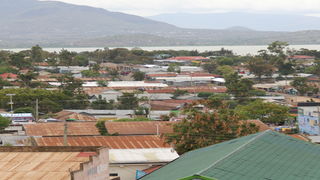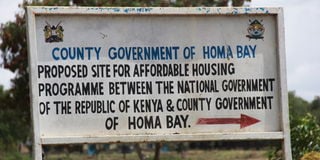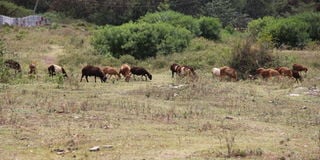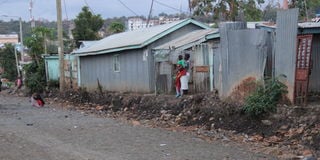
An aerial view of Shauri Yako, an informal settlement in Homa Bay Town on April 22, 2021.
Homa Bay
Premium
Homa Bay residents suffer as housing land turns into grazing field
An aerial view of some residential areas in Homa Bay Town paints the picture of a mountain of rusty metals at a scrap yard.
In one of the largest counties in Nyanza, a majority of people live in shacks made of wood and corrugated iron sheets in Shauri Yako, Makongeni, Got Rabuor, Sophia and Misita slums where the average rent is Sh2,500.
Unlike Oyugis and Rongo, thousands of Homa Bay Town residents spend their days in squalid, miserable conditions despite the fact that it’s the county headquarters.
Although these dwellings are bursting with energy, life is a daily struggle due to unemployment, risk of disease outbreak and crime – mainly robbery, burglary, mugging and rape.
Residents lack basic necessities like safe drinking water, electricity supply and sewage disposal due to overcrowding and the heterogeneous population. They also lack access to schools and health services.
On sunny days, the metal sheets get too hot and turn into ‘ovens’. You will see women huddled together with their children outside their shacks for the cool breeze from the lake. At night, when the temperature cools down, the converse happens.

A sign post showing the housing project in Homa Bay town on April 22,2021.
Kepher Sigona, a housing expert, says the town’s ‘loose loam soil’ discourages the construction of permanent buildings.
“Weak soil needs a lot of concrete and metal to make the foundation strong. This is expensive and that’s why most residents build houses made of iron sheets,” he offers.
The challenge is that most landlords do not consider provision of basic amenities when putting up rental houses. Some shacks are even built near roads.
Some families in Shauri Yako were recently evicted to pave way for the installation of water pipes in a project at the shores of Lake Victoria funded by the Belgian government. Others were displaced when the government began constructing a road slap-bang in the middle of the informal settlement.
Both projects are ongoing and more families could be displaced in future.
Some residents bury their kin in the slums, sharply dividing opinion among local government officials and the community.
In Kisumu County, for instance, the local government has banned burials in some residential areas for fear of driving away potential investors.

Animals graze on the 18 acre piece of land in Homa Bay Town that was set aside by the county government of Homa Bay for construction of affordable houses.
David Oluoch, 85, is a landlord in Shauri Yako whose tenants have raised complaints about the latrine. It’s full and could easily lead to a disease outbreak, they say.
His houses are not connected to the Homa Bay Water and Sewerage Company (Homawasco) and tenants depend on water bowsers for the precious commodity. Never mind that most people live less than five kilometres from the lake.
“Devolution led growth of population and most people who had idle land saw this as an opportunity to build rental houses. There was, however, a challenge of planning. Most people built shacks without considering water supply and sanitation,” he says.
Zilper Aoko lives in a mud-walled house and uses firewood for cooking in a neighbourhood with modern homes. She appears the odd one out in an estate that is rapidly embracing modernity.
Aoko, who has lived here for more than 60 years, is among a group of people whose ancestral homes are within the town.
“I won’t leave my home for any other place. All these developments were brought about by devolution. It was very quiet here. I will be buried here,” she says.
Before 2013, most of the informal settlements were farmlands and grazing fields.
Landowners are cashing in from the housing crisis fuelled by the wheels of devolution eight years ago. There were hopes of better facilities when the Jubilee government introduced the affordable housing agenda.
The county government set aside 18 acres of land in April 2018 that was to be used in the construction of low-cost houses.

Some of the houses in Homa Bay town where majority of residents live.
The project was to be undertaken by the Department of Housing, Urban Development and Public Works and was to create at least 10,000 jobs during the construction project.
Principal Secretary Charles Mwaura had said that the State would construct 2,000 homes after the signing of a memorandum of understanding between the county government and the department of housing.
Three years later, however, nothing has happened.
The parcel of land is now a grazing field and the only evidence for the project is a sign board that reads: “Proposed site for affordable housing between the national government of the Republic of Kenya and the county government of Homa Bay.”
In his state of the county address on March 17, Governor Cyprian Awiti said his administration supports President Kenyatta’s Big Four Agenda on housing.
“My administration has facilitated access to land for the construction of 2,000 affordable housing units in Homa Bay town. It has also constructed Appropriate Materials and Building Technology (ABMT) Centre in Ndhiwa towards training and empowering of our youth on the use of affordable and appropriate building materials through application of Interlocking Stabilized Soil Blocks (ISSBs),” said Mr Awiti.
“This will support the construction of affordable housing agenda of the present.”
Homa Bay County Lands and Housing Executive Roseline Odhiambo and chief officer Charles Obondo did not answer our calls and did not respond to text messages sent to them.
A communications officer at the governor's office promised to seek their response later.





